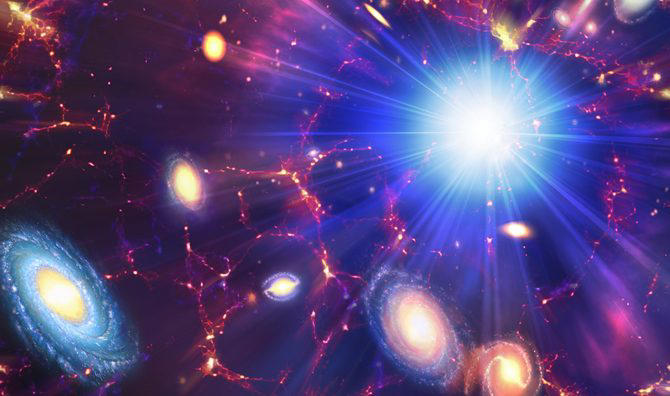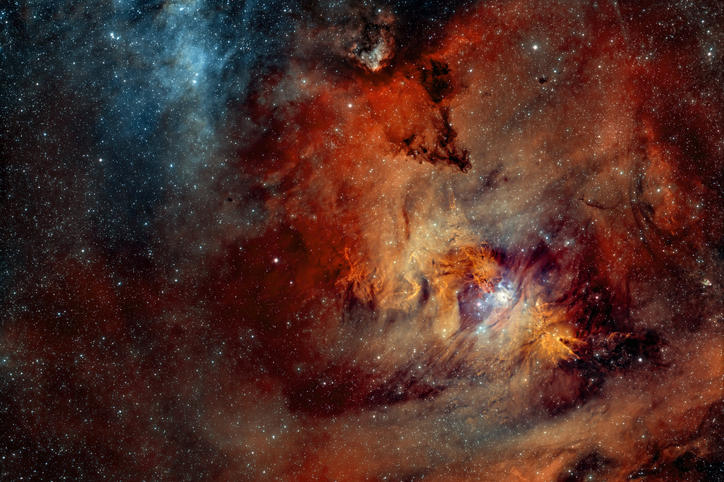Nina Massey, PA Science Correspondent
Mon, 23 October 2023

Astronomers have carried out the biggest ever computer simulations, from the Big Bang to the present day, to investigate how the universe evolved.
The project, dubbed Flamingo, calculated the evolution of all components of the universe – ordinary matter, dark matter and dark energy – according to the laws of physics.
As the simulations progress, virtual galaxies and galaxy clusters emerge in detail.
Facilities such as the Euclid Space Telescope recently launched by the European Space Agency (ESA) and Nasa’s James Webb Space Telescope collect data on galaxies, quasars and stars.
Researchers hope the simulations will allow them to compare the virtual universe with observations of the real thing being captured by new high-powered telescopes.
This could help scientists understand if the standard model of cosmology – used to explain the evolution of the universe – is a good description of reality.
Flamingo research collaborator Professor Carlos Frenk, Ogden Professor of Fundamental Physics, at the Institute for Computational Cosmology, Durham University, said: “Cosmology is at a crossroads.
“We have amazing new data from powerful telescopes some of which do not, at first sight, conform to our theoretical expectations.
“Either the standard model of cosmology is flawed or there are subtle biases in the observational data.
“Our super precise simulations of the universe should be able to tell us the answer.”
Past simulations, which have been compared to observations of the universe, have focused on cold dark matter – believed to be a key component of the structure of the cosmos.
However, astronomers now say that the effect of ordinary matter, which makes up only 16% of all matter in the universe, and neutrinos, tiny particles that rarely interact with normal matter, also need to be taken into account when trying to understand the universe’s evolution.
Principal investigator Professor Joop Schaye, of Leiden University, said: “Although the dark matter dominates gravity, the contribution of ordinary matter can no longer be neglected since that contribution could be similar to the deviations between the models and the observations.”
Researchers ran simulations at a powerful supercomputer in Durham over the past two years.
The simulations took more than 50 million processor hours on the Cosmology Machine (COSMA 8) supercomputer, hosted by the Institute for Computational Cosmology, Durham University, on behalf of the UK’s DiRAC High-Performance Computing facility.
In order to make the simulations possible, the researchers developed a new code, called SWIFT, which distributes the computational work over thousands of central processing units (CPUs, sometimes as many as 65,000).
Flamingo is a project of the Virgo Consortium for cosmological supercomputer simulations. The acronym stands for full-hydro large-scale structure simulations with all-sky mapping for the interpretation of next generation observations.
Funding for the project came from the European Research Council, the UK’s Science and Technology Facilities Council, the Netherlands Organisation for Scientific Research and the Swiss National Science Foundation.
The research is published in the journal Monthly Notices of the Royal Astronomical Society.
Biggest-ever supercomputer creates 'identical twin' universe

Scientists are still trying to understand exactly how the universe formed
(Picture: Getty/Science Photo Libra)© Provided by Metro
Astronomers have carried out the biggest ever ‘supercomputer’ simulations, from the Big Bang to the present day, to help answer some of the universe’s biggest mysteries.
The aim is to compare the virtual universe with what we know of the real thing, including new information being captured by high-powered telescopes – which sometimes does not quite match what is expected.
This could help scientists understand if the current theory of how the universe evolved – known as the Standard Model of Cosmology – is a good description of reality.
The project, dubbed Flamingo, calculated the evolution of all components of the universe – ordinary matter, dark matter and dark energy – according to the laws of physics.
As the simulations progress, virtual galaxies and galaxy clusters emerge in detail.
Facilities such as the Euclid Space Telescope, recently launched by the European Space Agency (ESA), and Nasa’s James Webb Space Telescope collect data on galaxies, quasars and stars.
‘Cosmology is at a crossroads,’ said Flamingo research collaborator Professor Carlos Frenk, from Durham University.
‘We have amazing new data from powerful telescopes some of which do not, at first sight, conform to our theoretical expectations.
‘Either the standard model of cosmology is flawed or there are subtle biases in the observational data.
‘Our super precise simulations of the universe should be able to tell us the answer.’

The Christmas Tree Cluster, a young cluster still forming in the constellation Monoceros (Picture: Getty)© Provided by Metro
Past simulations, which have been compared to observations of the universe, have focused on cold dark matter – believed to be a key component of the structure of the cosmos.
However, astronomers now say that the effect of ordinary matter, which makes up only 16% of all matter in the universe – including the Earth and everyone on it – and neutrinos, tiny particles that rarely interact with normal matter, also need to be taken into account when trying to understand the universe’s evolution.
Researchers have been running simulations at a powerful supercomputer in Durham over the past two years.
The simulations took more than 50 million processor hours on the Cosmology Machine (COSMA 8) supercomputer, hosted by the Institute for Computational Cosmology, Durham University, on behalf of the UK’s DiRAC High-Performance Computing facility.
Flamingo is a project of the Virgo Consortium for cosmological supercomputer simulations. The acronym stands for full-hydro large-scale structure simulations with all-sky mapping for the interpretation of next generation observations.
Funding for the project came from the European Research Council, the UK’s Science and Technology Facilities Council, the Netherlands Organisation for Scientific Research and the Swiss National Science Foundation.
The research is published in the journal Monthly Notices of the Royal Astronomical Society.
Get your need-to-know latest news, feel-good stories, analysis and more by signing up to Metro's News Updates
Astronomers have carried out the biggest ever ‘supercomputer’ simulations, from the Big Bang to the present day, to help answer some of the universe’s biggest mysteries.
The aim is to compare the virtual universe with what we know of the real thing, including new information being captured by high-powered telescopes – which sometimes does not quite match what is expected.
This could help scientists understand if the current theory of how the universe evolved – known as the Standard Model of Cosmology – is a good description of reality.
The project, dubbed Flamingo, calculated the evolution of all components of the universe – ordinary matter, dark matter and dark energy – according to the laws of physics.
As the simulations progress, virtual galaxies and galaxy clusters emerge in detail.
Facilities such as the Euclid Space Telescope, recently launched by the European Space Agency (ESA), and Nasa’s James Webb Space Telescope collect data on galaxies, quasars and stars.
‘Cosmology is at a crossroads,’ said Flamingo research collaborator Professor Carlos Frenk, from Durham University.
‘We have amazing new data from powerful telescopes some of which do not, at first sight, conform to our theoretical expectations.
‘Either the standard model of cosmology is flawed or there are subtle biases in the observational data.
‘Our super precise simulations of the universe should be able to tell us the answer.’

The Christmas Tree Cluster, a young cluster still forming in the constellation Monoceros (Picture: Getty)© Provided by Metro
Past simulations, which have been compared to observations of the universe, have focused on cold dark matter – believed to be a key component of the structure of the cosmos.
However, astronomers now say that the effect of ordinary matter, which makes up only 16% of all matter in the universe – including the Earth and everyone on it – and neutrinos, tiny particles that rarely interact with normal matter, also need to be taken into account when trying to understand the universe’s evolution.
Researchers have been running simulations at a powerful supercomputer in Durham over the past two years.
The simulations took more than 50 million processor hours on the Cosmology Machine (COSMA 8) supercomputer, hosted by the Institute for Computational Cosmology, Durham University, on behalf of the UK’s DiRAC High-Performance Computing facility.
Flamingo is a project of the Virgo Consortium for cosmological supercomputer simulations. The acronym stands for full-hydro large-scale structure simulations with all-sky mapping for the interpretation of next generation observations.
Funding for the project came from the European Research Council, the UK’s Science and Technology Facilities Council, the Netherlands Organisation for Scientific Research and the Swiss National Science Foundation.
The research is published in the journal Monthly Notices of the Royal Astronomical Society.
Get your need-to-know latest news, feel-good stories, analysis and more by signing up to Metro's News Updates
No comments:
Post a Comment